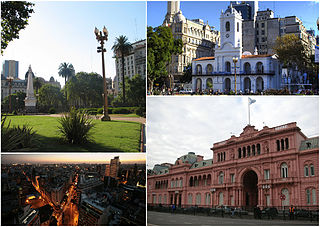
Florida Street is a popular shopping street in Downtown Buenos Aires, Argentina. A pedestrian street since 1971, some stretches have been pedestrianized since 1913.

The Plaza de Mayo is a city square and main foundational site of Buenos Aires, Argentina. It was formed in 1884 after the demolition of the Recova building, unifying the city's Plaza Mayor and Plaza de Armas, by that time known as Plaza de la Victoria and Plaza 25 de Mayo, respectively. The city centre of Buenos Aires, Plaza de Mayo has been the scene of the most momentous events in Argentine history, as well as the largest popular demonstrations in the country. On the occasion of the first anniversary of the May Revolution in 1811, the Pirámide de Mayo was inaugurated in the square's hub, becoming Buenos Aires' first national monument.

Retiro is a barrio or neighborhood in Buenos Aires, Argentina. Located in the northeast end of the city, Retiro is bordered on the south by the Puerto Madero and San Nicolás, and on the west by the Recoleta.

Monserrat in the simplified Spanish spelling or, originally, Montserrat is a neighbourhood in the east of the Buenos Aires CBD. The district features some of the most important public buildings in Buenos Aires, including city hall, the city legislature, Casa Rosada, the Colegio Nacional de Buenos Aires and the Libertador Building, among others.

Avenida Rivadavia is one of the principal thoroughfares in Buenos Aires, Argentina, extending 23 miles (37 km) from downtown Buenos Aires to the western suburb of Merlo.
There are many landmarks in Buenos Aires, Argentina some of which are of considerable historical or artistic interest.

Buenos Aires City Hall was, until 2015, the seat of the Office of the Chief of Government of Buenos Aires, the capital city of Argentina. From its construction in 1914 to the reformation of the city's constitution in 1996, the building was the seat of the City Municipality. It faces the Plaza de Mayo, across from the Casa Rosada presidential palace, in the barrio of Monserrat.

Manuel Canaveris was an Argentine army officer, who took part in the defense and reconquest of Buenos Aires during the English Invasions. He served under Colonel Ignacio Álvarez Thomas in the 4th Regiment of Buenos Aires, participating in the Campaigns to the Interior of the Provinces of 1810.

Enrico Mosconi (1843-1910) was an Italian engineer and the father of the General Enrique Mosconi. He actively participated in the construction of the railways in the Argentine Republic.

Isabelino Canaveris was an Uruguayan patriot, military, revolutionary and politician, who served as president of the National Party in the Argentine. He participated in most of the armed confrontations between the Blancos and Colorados.

Avenida Presidente Julio Argentino Roca better known as Diagonal Sur, is an important avenue in the Monserrat neighborhood of Buenos Aires, Argentina. It is oriented north-east/south-west, diagonally bisecting the city blocks (manzanas) which give the city centre a checkerboard plan. It is named after President Julio Argentino Roca, who held power from 1880 to 1886, and from 1896 to 1904.
Juan Manuel Canaveris (1804-1868) was an Argentine jurist and politician, who served in Buenos Aires and Montevideo as attorney, teacher and military man. He participated of the escort of honor in the funerals of Manuel Dorrego, and collaborated in the early days of government of Juan Manuel de Rosas.
Héctor Canavery was an Argentine politician and military man, who took part in the military campaigns in the territory of Patagonia. He also dabbled in politics, serving as a legislator for the National Autonomist Party.

Baldomero Lamela (1838-1901) was an Argentine army officer, who took part in the Argentine Civil Wars and War of the Triple Alliance. He also had an active participation in the Conquest of the Desert, serving under the command of the General Julio Argentino Roca, during the expeditions in southern Argentina.
Sinforoso Canavery was an Argentine jurist, who served as a notary public in the cities of Buenos Aires and La Plata, and as Notary Mayor of Government of Buenos Aires Province towards the end of the 19th century. He had an active participation in public contracts of the province of Buenos Aires, where he served for more than thirty years. His works as a notary, also includes his participation in the deeds of The Tramway Rural.

José Antonio Terry was an Argentine lawyer and politician, who served as Minister Plenipotentiary of the Argentine Republic.
Bartolomé Saraví (1797–1862) was an Argentine army officer who toke part in the Argentine War of Independence. He served as General Minister of La Rioja Province, Argentina during the government of Vicente Mota in 1847.

A la Ciudad de Londres was a traditional European store, which operated Buenos Aires from 1872 to 1922. It was the first large clothing store established in the city of Buenos Aires towards the end of the 19th century.
Floro Vega was an Argentine military man and politician, who served as Edecan of the Government of the Province of Buenos Aires. He participated in several military conflicts, including the Battle of Caseros and Conquest of the Desert.


















